Scales of baroclinic instability in the ocean:
In this paper we compared two measures of the eddy forcing scale, for the ocean (from observations) and for the Eddying Double Drake, to show: that the two measures give similar scales, and that the inverse energy cascade acts only over a modest range of horizontal scales. At low latitudes where there is typically a reversal in the zonal mean shear near the surface, baroclinic instability acts at scales smaller than the deformation scale. Meanwhile at high latitudes where the flow is westerly sheared baroclinic instability acts on larger scales than the deformation scale (i.e. instability between the barotropic and first baroclinic modes). This asymmetry between easterly (low latitude) and westerly (high latitude) sheared flows results in a weaker dependence against latitude of the eddy forcing scale (and the resulting eddy scale) compared to the deformation scale, as shown figures below.
Collocation of steering levels and eddy mixing:
In this paper we emphasize the importance of steering levels on horizontal eddy mixing. Following linear theory from Green (1970) we expect that the eddy diffusivity should depend on the eddy kinetic energy as well as the difference between the mean flow and the eddy phase speed (and the eddy growth rate). Shown below on the left is a zonally-averaged cross-section of the meridional gradient of the quasigeostrophic potential vorticity (QGPV), with white shaded regions having values close to zero. The black dots show the steering level depths, i.e. where the mean zonal velocity equals the phase propagation speed, which correlate very well with QGPV gradient zero crossings. On the right is a cross-section of the effective diffusivity, computed by Ryan Abernathey over the same region in the Eddying Double Drake. The dots on the right indicate the depths where the zonal mean velocity equals the phase speed of the fastest growing linear modes computed from a linear instability analysis about the mean flow and stratification. The mixing, QGPV gradient zero crossings and steering levels are all closely correlated.
Eddying Double Drake
zonally averaged length scales
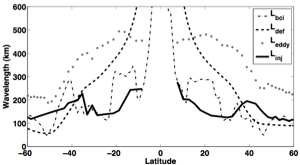
Emergence of zonal jets:
The main, large scale jets in the ocean are primarily wind driven, however depending on what temporal averaging is used the ocean can appear to be full of zonal jets. In a paper soon to be submitted with John Marshall and Majid Mohamadian, we argue (as Rhines did in 1975) that the emergence of zonal jets only happens where the time scale of the turbulence is slower than the time scale of linear Rossby waves. We illustrate this using Majid’s point vortex model on the sphere (not shown) and results from the Eddying Double Drake. In the Eddying Double Drake, jets ought to occur in an inverted wine glass shaped region about the equator, with jets out to higher latitudes at depth than at the surface. The movie below shows the evolution of a passive tracer inserted at a depth of 900m.
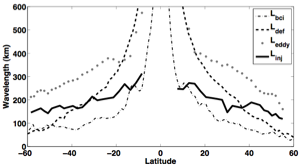
Ocean’s
zonally averaged length scales

Research

Higher-order surface QG turbulence:
For my masters thesis I studied cyclone-anticyclone asymmetry in a higher Rossby order balanced surface model of the tropopause with David Muraki at Simon Fraser University. In a follow-up to Hakim et al. (2002) which quantified cyclone-anticyclone asymmetry in freely decaying sQG+1 turbulence, we considered the effect of adding a free surface boundary to sQG+1 (i.e. fsQG+1). We found that the asymmetry in magnitude and radius between cyclones and anti-cyclones was weakened as the surface became more flexible. This result is in partial agreement with Polvani et al. (1994) who studied cyclone-anticyclone asymmetry in freely decaying shallow water turbulence and found the opposite asymmetry compared to sQG+1, i.e. cyclones stronger than anticyclones.
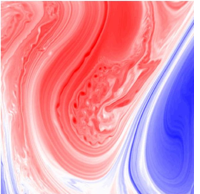

Predictability of the meridional overturning circulation (ongoing):
Variations in the strength of the Atlantic meridional overturning circulation (MOC) are thought to impact hurricane activity as well as global precipitation and surface temperature patterns. Numerous observational and modeling studies indicate that significant MOC variability occurs on decadal and multi-decadal time scales, which hints at the possibility of decadal MOC prediction. However MOC variability is still poorly understood because observations are scarce and modeling studies have not yet converged on the mechanism of the variability.
Most previous modeling studies have used either state of the art coupled climate models or uncoupled, reduced equation set, box models. We (John Marshall, Martha Buckley, David Ferreira, and Jean-Michel Campin) are studying a coupled model of intermediate complexity called the “Double Drake” which reproduces many aspects of Earth’s mean climate (Ferreira et al. 2009). The Double Drake has two meridional ridges which extend from the North Pole to 35°S (shown below) which create a large/fresh basin (Pacific-like), a small/salty (Atlantic-like) basin, and a southern circumpolar current.
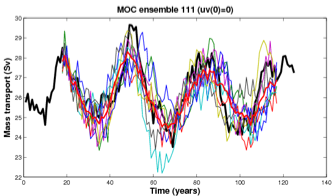
The Eddying Double Drake:
The Double Drake described above reproduces Earth’s climate very well, however it does not resolve the oceanic mesoscales. The Eddying Double Drake, shown on the right, is a higher resolution (15-20km) ocean only model, forced by fixed, zonally symmetric winds from the Double Drake climatology. These winds put available potential energy into the ocean by tilting isopycnals, which is then extracted by mesoscale eddies. The snapshot on the right is of relative vorticity, centered at the western boundary current of the large basin (which is like the Kuroshio Current). White latitude lines are at every 15° delineate the western boundary current (eastward flowing) between 30°N and 45°N, the westward flowing return flow between 15°N and 30°N and the linear wave dominated tropical band between 15°S and 15°N. The movie below shows an overview of the all of the regions.
The Eddying Double Drake is interesting for studying eddy dynamics (see the following sections) because it is both Earth-like and free of complicating factors like stochastic forcing, seasonal cycles, bottom topography, etc.
Westward propagation of oceanic eddies:
During my PhD, I investigated the observed westward phase propagation of sea surface height (SSH) anomalies in the ocean. Chelton and Schlax (1996) first noticed that SSH anomalies at higher latitudes propagate faster than Rossby wave theory predicts for a resting ocean. In our paper, we found that the propagation is consistent with linear waves driven by a mean flow at low latitudes but not at high latitudes, where the root mean square (turbulent) velocity is larger than the observed phase speed. We argue that the tropical band is dominated by linear waves while the mid-latitudes are dominated by nonlinear turbulence.



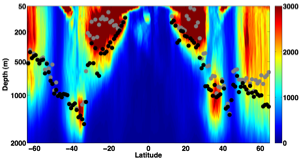
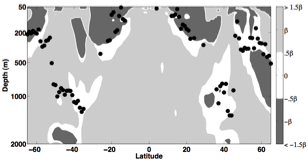
Introduction:
I am a physical oceanographer interested in the mesoscale and decadal variability of the ocean. With a background in applied mathematics, my earlier work focussed on theoretical geophysical fluid dynamics (GFD) problems, such as the asymmetry between cyclones and anticyclones and the distribution of energy across spatial scales in the atmosphere.
My current work addresses long standing questions in oceanography using arguments from GFD theory applied to observational data as well as data from an idealized, eddy permitting general circulation model. Such questions include: the phase speed of propagation of eddies, the emergence of zonal jets, the effect of steering levels on eddy mixing, and the scales of baroclinic instability in the ocean. I am also currently involved in a project to assess the predictability of the meridional overturning circulation in the Atlantic ocean.
The variability of the MOC in the small basin of the Double Drake is dominated by a 30-35 year mode as shown on the left below (black line). These MOC variations are primarily the result of large, westward propagating temperature anomalies near 60°N in the small basin as shown in the movie on the right below (the fonts are a bit small but they are visible on youtube). The MOC variability shown on the left is regular enough that it can be considered an oscillation. The figure shows the result of an ensemble of “perfect initial condition” simulations where each member of the ensemble is initialized with the same (year 17) ocean state but different atmospheric state. The red line is the mean of the ensemble and it tracks the control run (black line) very well over a couple of cycles.
Our model appears to be very predictable. However we still need to understand the mechanism of variability, whether there are optimal perturbations that lead to fast error growth which will reduce the predictability, and how this oscillation relates to MOC variability seen in more complex models and in observations.
Eddying Double Drake
meridional QGPV gradient
Eddying Double Drake
effective diffusivity
Surface quasigeostrophic effects in QG turbulence:
The bulk of my PhD thesis was devoted to studying boundary effects in geostrophic turbulence and how they relate to the energy spectrum in the atmosphere with my advisor Shafer Smith. In balanced QG flow, the interior behaves quasi-two dimensionally, while surface dynamics prevail at the upper and lower boundaries. If the forcing is such that both the interior and surface components are energized then one obtains kinetic energy at the surface which is dominated by quasi-2D interior flow at large scales and by 3D-like surface QG flow at small scales (visible in the figure on the right). We find that the resulting power spectral density of kinetic energy at the upper boundary of our balanced model compares well with atmospheric observations near the tropopause. See our papers 1, 2, 3 for details.


